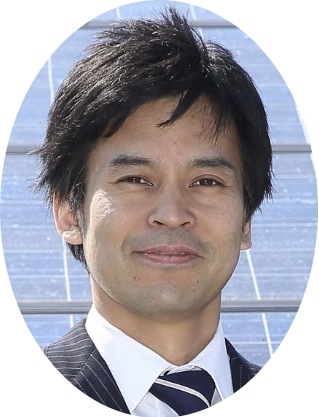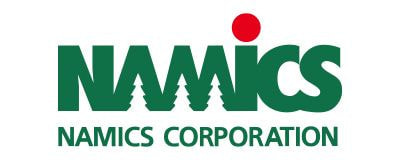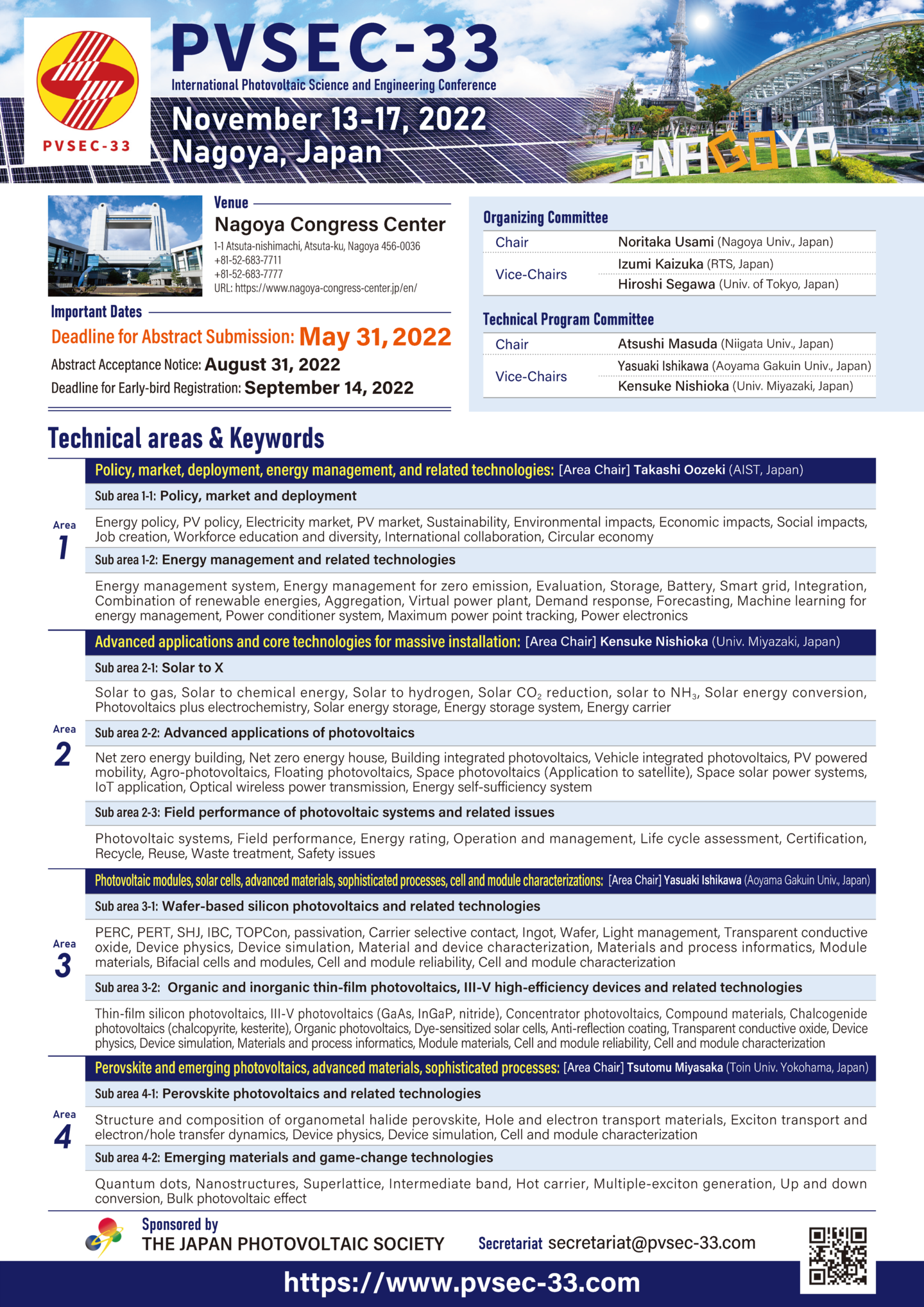Tutorials

Tutorials

Time table
Date: Nov. 13th, 2022 (Sunday)
The PVSEC-33 tutorials will be held at the conference venue and online on Sunday, November 13th, 2022. The tutorials are open to all delegates at an additional fee. The tutorial topics and time schedule are listed below.
Two topics of “PV Materials” and “PV Systems” will be given, and participants can attend either topic. Tutorial fee is JPY 10,000.
| Time (JST, UTC+9) | PV Materials | PV Systems |
| 10:00-11:45 | (T-M-01) Solar Cells: Fundamental to Application for Carbon Neutrality |
(T-S-01) Reliability and Testing of PV Modules |
| 11:45-13:30 | Break | Break |
| 13:30-15:15 | (T-M-02) Machine Learning and its Application to Research and Development of Photovoltaics - Materials Informatics, Process Informatics and Measurement Informatics for PV – |
(T-S-02) PV Power Forecasting and its Uncertainty |
| 15:15-17:00 | (Tentative) (T-M-03) Perovskite Solar Cells -Fundamentals and Applications- |
(T-S-03) Promising New Applications of Photovoltaic - Solar to X, Building Integrated PV, Vehicle Integrated PV, Agrivoltaic - |
Presenter & Abstract

T-M-01
Solar Cells: Fundamental to Application for Carbon Neutrality
Takashi Minemoto (Ritsumeikan Univ., Japan)
A solar cell is a promising electrical device for clean energy conversion. The scientific and technical area of solar cells are broad such as operation principle, theoretical limit (S-Q limit), single junction and tandem configuration, absorber materials (crystalline Si, CdTe, CIS, perovskite, organic thin-film, thin-film Si, etc.), module fabrication process, characterization, PV system, application, and system (FIT and FIP). In this tutorial, the overview of solar cell technology will be discussed.

T-M-02
Machine Learning and its Application to Research and Development of Photovoltaics
- Materials Informatics, Process Informatics and Measurement Informatics for PV –
Kentaro Kutsukake (RIKEN, Japan)
Today, machine learning, a method derives useful rules from data, is applied to the various research field in photovoltaics, including material search, process optimization, and material and device characterizations. This tutorial will provide a survey of the machine learning applications to PV research, such as Bayesian optimization for process conditions and real-time prediction of material properties, as well as a brief introduction to machine learning.

T-M-03
Perovskite Solar Cells
-Fundamentals and Applications-
Shuzi Hayase (Univ. Electro-Communicaions, Japan)
The certified efficiency of the Pb perovskite solar cell is 25.5 % and is approaching the 26.7% of the single crystalline Si solar cells. It is incredible that the high efficiency was achieved by the cell prepared with a simple low temperature-printing process, where a lot of impurities should remain in the film. The fundamental for the high efficiency is discussed from the viewpoint of the defect tolerance properties. In addition, the recent research trends of the perovskite tandem cells and Pb free perovskite solar cells are reviewed, and the issues to be solved are disclosed. The enhancement of the efficiency for the Sn and SnPb perovskite solar cells expected as the perovskite tandem cells is discussed, while comparing it with the Pb perovskite. Finally, the new applications of these solar cells are reviewed.


T-S-01
Reliability and Testing of PV Modules
Tadanori Tanahashi (AIST, Japan)
Kengo Morita (PVSQ Management, Japan)
Strong market expansion in the PV sector towards achieving carbon neutrality requires easy access to reliable information on the performance and durability of PV systems. The first part of this session will present the current status of these indicators, as reviewed and reported by the global experts in the International Energy Agency (IEA) PVPS Task 13 (https://iea-pvps.org/research-tasks/performance-operation-and-reliability-of-photovoltaic-systems/). And in the following part, the accurate performance evaluation cases in the field for the both total system level and individual module level will be introduced. Additionally, we will discuss the re-powering process by replacing the defective facility (PV module etc.), which results in the increase of the generated energy.

T-S-02
PV Power Forecasting and its Uncertainty
Hideaki Ohtake (AIST, Japan)
Weather forecasting technology, which is the base technology for PV power forecasting, will be presented. In recent years, large errors in PV power forecasts have become an issue in power grid operations.In the field of PV power forecasting, the uncertainty of the forecast is being discussed. Technical issues related to ensemble forecasting, in which multiple forecasts are made, will also be introduced.

T-S-03
Promising New Applications of Photovoltaic
- Solar to X, Building Integrated PV, Vehicle Integrated PV, Agrivoltaic -
Kensuke Nishioka (Univ. Miyazaki, Japan)
PV technologies have evolved rapidly and high-quality products are available at low cost. Challenges to new applications of PV are indispensable for the further spread of PV. This tutorial describes solar to X, building integrated PV, vehicle integrated PV, and agrivoltaic, which are promising new applications for PV. We hope that you will feel that the basic technologies of PV are useful for the latest applications.




























